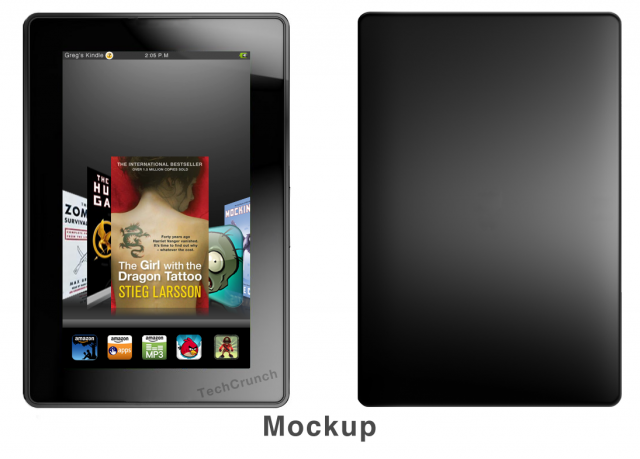
Tablets are everywhere. It seems like a new one is being announced, leaked or rumored every week. One lucky tablet that has been subjected to mounding rumors is the Amazon Kindle tablet, and thanks to MG Siegler and Greg Kumparak of TechCrunch, we're now one step closer to discovering what exactly this reader-tablet machine really is.
Unfortunately, the deal that Siegler agreed to meant that there would be no actual pictures taken, we have to go solely off of his word – perfect for kindling a little hype. But what we do know is that Amazon has altered their focus over the summer. The tablets are no longer launching together; the 7-inch tablet we'd heard about will launch first in November and if it does well, a 10-incher will launch in Q1 2012. According to Sielger, Amazon has cut the cost down quite a bit and the tablet will launch for a mere $250. That drop also affects the specifications. No longer is the 7-inch Kindle-Android fusion going to be sporting a dual-core processor, but a single-core instead. It's a tablet that runs Android, but if you suspect it to run Honeycomb or Ice Cream Sandwich, you would be terribly wrong. Siegler believes it's running a version of Android prior to 2.2. Nonetheless, both MG and Kumparak both have a feeling this Kindle tablet will be huge.
Quite honestly, I fail to see what's so significant about it. For starters, there is already a Nook Color for the same price, which is a low-end Android tablet running a modified version of Froyo, sporting a single-core processor. The only major difference (that we know of) besides hardware design is that the Kindle will be heavily centered around Amazon's services like Amazon Cloud Player for music, the Kindle app for reading, Instant Video service for movie playing, etc. Siegler did add that buyers would be offered a free subscription to Amazon Prime. (A Prime subscription normally costs $79 per year and gives Amazon buyers a few added perks.)
Also, there is no sign of “Google” anywhere on the Kindle, the Android Market has been totally replaced by Amazon's Appstore and there are absolutely no Google apps. The interface has been completely tweaked and features a carousel of content, much like Cover Flow in iTunes. In other words, you likely won't feel like you're using Android at all. That could be a good or bad thing.
The Kindle tablet is simply a necessary step Amazon must take to keep the eReader market alive and well. Kumparak makes a strong point that the Kindle tablet will be everything the iPad is not: it's 7-inches versus 10-inches, lightweight, more portable, and so on and so forth. But it's not the first in its class and hardly groundbreaking.
This is what eReaders have to become in order to survive. It is not a matter of innovating a new class of devices and looking onward an upward. This is Amazon realizing that the tablet market is quickly coming around and more people are prone to buy a device they can do almost everything with, versus buying an eReader which is extremely limited in functionality. This merger … no, this fusion of tablets and eReaders was inevitable and Amazon has been beaten to the punch by their largest eReader competitor, Barnes & Noble with the Nook. It will now boil down to who will be first to do it again with an LCD/E Ink hybrid display.
As you all probably know eReaders are perfect for kicking back on the couch and knocking out a novel or two. Instead of the backlit display, they sport a display technology called E Ink, which looks more like print than a display. Both Barnes & Noble and Amazon have abandoned this display technology for backlit, LCD displays in the Nook Color and Kindle tablet. This will neither appeal to people who specifically want an eReader or a tablet, mainly because the display puts more strain on the eyes for those who read for hours on end, and by comparison, these tablets are severely under-powered. Sure, they're half the price of most other tablets, but someone who truly wants a tablet should honestly consider spending $150 more for something like a Transformer or Acer Iconia. Or they should fight the masses for the second batch of TouchPads.
For those of you hoping Amazon was aiming to finally put Android on the map with high-end Android tablets sporting competitive prices, don't hold your breath. For one, this is hardly an “Android tablet.” Sure, it does run Android, but that's just a technicality. It's not the Google experience you are looking for, it's an Amazon services consumption tablet. Of course, there's always hope that someone will hack it seven ways 'till Sunday and put the full Android experience on it. But how well it will run something like Honeycomb or Ice Cream Sandwich is unclear.
Maybe I'm not seeing the whole picture here, or just overlooking some key ingredient. What say you, guys and gals? Will the Amazon Kindlet (that's what I'm calling it) with Android be a hit? Or will it come and go without as much as a peep?
Image via TechCrunch